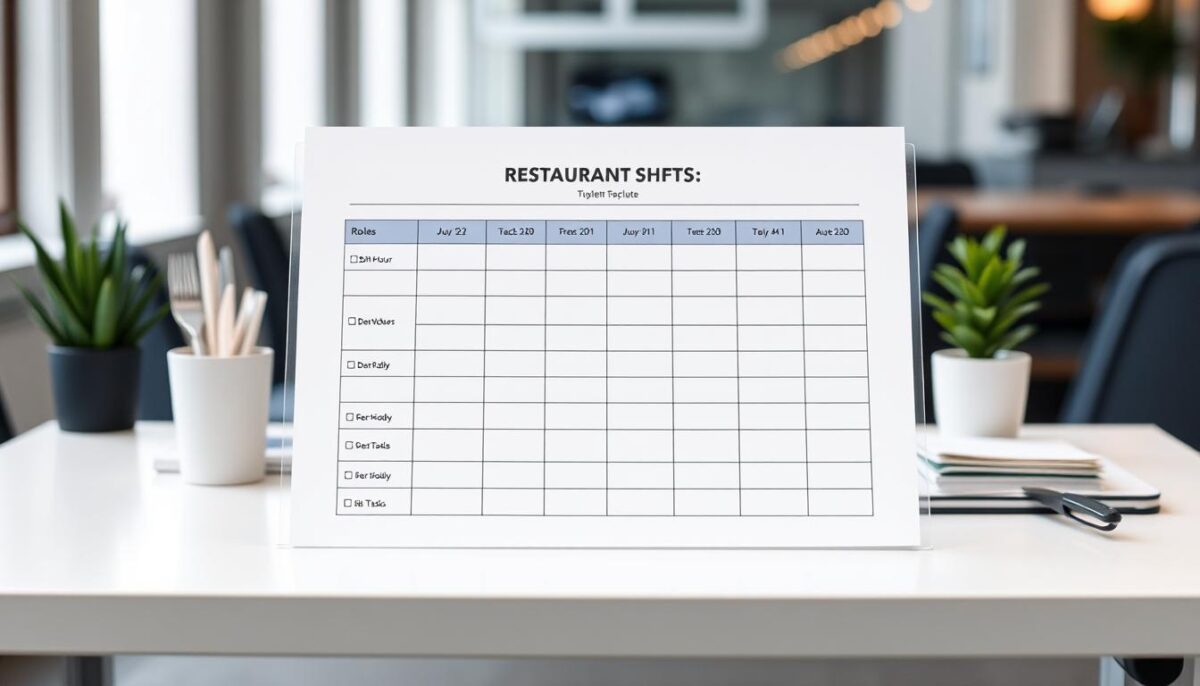
How to Build Staff Schedules in 10 Minutes Using Our Template
August 27, 2025
Restaurant Loyalty Hacks That Drive 25% More Repeat Business
August 28, 2025Running a restaurant is a high-pressure job, and managing employee shifts can feel like a never-ending challenge. I’ve seen many managers struggle with sticky notes, group messages, and last-minute shift swaps, but it doesn’t have to be this way.
Did you know that inefficient scheduling can lead to significant labor costs? In fact, a recent study found that many restaurants overspend on overtime due to poor scheduling practices. By adopting the right staff scheduling strategy, you can eliminate unnecessary costs and improve operational efficiency.
So, what’s the secret to scheduling restaurant staff smartly? It starts with understanding the challenges and opportunities in your restaurant’s scheduling process.
Key Takeaways
- Understand the impact of inefficient scheduling on labor costs.
- Learn how to implement a smart scheduling strategy.
- Discover the benefits of reducing overtime costs.
- Improve employee morale through fair and transparent scheduling.
- Enhance operational efficiency with optimized staff scheduling.
The Hidden Costs of Poor Restaurant Scheduling
Restaurant owners often overlook the hidden costs associated with poor scheduling, which can silently drain profits and demotivate staff. The impact of inefficient scheduling practices in the restaurant industry is multifaceted, affecting both the bottom line and employee morale.
Financial Impact of Overtime and Overstaffing
The financial implications of poor scheduling are significant. Overtime and overstaffing can lead to unnecessary expenses, cutting into profit margins. Studies have shown that around 80% of employees in the hospitality industry experience burnout, leading to issues like unhealthy working conditions and revenue loss. By optimizing scheduling, restaurant owners can mitigate these costs and improve their financial health.
How Inefficient Scheduling Affects Employee Morale
Inefficient scheduling practices can have a profound effect on restaurant staff morale. Unpredictable schedules create stress and dissatisfaction among employees, affecting their work-life balance and overall job satisfaction. This can lead to decreased service quality and customer satisfaction, further impacting the restaurant’s reputation and bottom line. By creating more predictable and fair schedules, restaurant owners can boost employee morale and reduce turnover rates.
How to Schedule Restaurant Staff Smartly Using Data

To optimize restaurant operations, it’s essential to leverage data when scheduling staff. By doing so, restaurants can significantly reduce labor costs and improve overall efficiency.
Analyzing Sales Reports to Identify Peak Hours
Analyzing sales reports is a critical step in understanding peak hours and slow periods in your restaurant. By reviewing these reports, you can identify patterns in customer demand, allowing you to schedule staff more effectively.
Spend 10 minutes each week reviewing your schedule and asking key questions: Were there last-minute changes or no-shows? Did labor costs exceed your target? Did your schedule meet actual demand? This simple exercise can lead to significant improvements over time.
Setting Optimal Labor-to-Sales Ratios
The labor-to-sales ratio is a crucial metric for restaurant scheduling, as it directly impacts profitability. To set optimal labor-to-sales ratios, you need to understand your restaurant’s specific business model and industry benchmarks.
I’ll explain the concept of labor-to-sales ratio and provide industry benchmarks for optimal labor percentages across different restaurant types and service styles. By calculating your restaurant’s ideal labor-to-sales ratio and adjusting staffing levels accordingly, you can maintain target labor percentages during both slow and busy periods.
Effective staff scheduling using data involves more than just analyzing sales reports; it requires a comprehensive approach that includes setting optimal labor-to-sales ratios, accounting for fixed labor costs versus variable staffing, and communicating labor targets to your management team and staff.
Creating Effective Shift Templates by Role
Creating effective shift templates is crucial for restaurant managers looking to optimize staff scheduling. By developing templates that cater to different roles within the restaurant, managers can ensure that they have the right staff on hand at the right times.

Developing Default Schedules for Common Positions
One of the key steps in creating effective shift templates is developing default schedules for common positions within the restaurant. For instance, servers, bartenders, and kitchen staff have different peak hours and requirements. By establishing default schedules for these roles, restaurants can simplify the scheduling process. For example, a server might typically work a dinner shift, while a kitchen staff member might work a split shift covering both lunch and dinner preparations.
When developing these default schedules, it’s essential to consider the specific needs of each role and how they contribute to the overall operation of the restaurant. This involves analyzing sales data and customer traffic patterns to determine peak periods.
Balancing Fixed and Rotating Shifts
A crucial aspect of creating effective shift templates is balancing fixed and rotating shifts. Fixed shifts provide stability for employees, allowing them to plan their personal lives around their work schedules. On the other hand, rotating shifts help ensure that all employees gain experience across different shifts and periods, which can be beneficial for cross-training and flexibility.
Implementing a mix of both can help cover all bases. For instance, reliable employees can be given fixed shifts, while others can be on rotating shifts. Split shifts are particularly useful for covering busy hours without exhausting the team. When implementing rotating shifts, it’s crucial to create a balanced rotation system that is fair to all employees. This involves ensuring that everyone gets exposure to both high-volume and slower shifts.
To make this system work effectively, it’s essential to communicate shift changes and rotations clearly to minimize confusion and resistance among staff. By doing so, restaurants can create a more flexible and efficient scheduling system that benefits both the business and its employees.
Empowering Staff in the Scheduling Process
A key aspect of smart scheduling is empowering staff to manage their own time off and shift swaps. By giving employees more control over their schedules, restaurants can improve staff morale and reduce turnover.
Implementing a Time-Off Request System
Creating an efficient time-off request system is essential for empowering employees. This involves setting up a clear process for requesting time off, ensuring that requests are handled fairly and promptly. Using scheduling software with a built-in request system can streamline this process, making it easier for both employees and managers.
To implement an effective time-off request system, consider the following:
- Establish clear policies for requesting time off, including notice periods and blackout dates.
- Use technology to automate the request process, reducing administrative burdens.
- Ensure that managers review requests promptly to avoid scheduling conflicts.
Setting Up Shift Swap Protocols
Shift swaps are another critical aspect of employee empowerment in scheduling. By allowing staff to swap shifts, restaurants can provide flexibility while maintaining adequate coverage. However, it’s crucial to establish clear protocols to ensure that shift swaps don’t disrupt service or lead to overtime.
| Shift Swap Protocol | Description | Benefits |
|---|---|---|
| Manager Approval | Require manager approval for all shift swaps to ensure adequate coverage. | Prevents understaffing and maintains service standards. |
| Automated Swap Requests | Use scheduling software to facilitate shift swap requests and approvals. | Streamlines the swap process, reducing administrative tasks. |
| Overtime Monitoring | Monitor shift swaps to prevent excessive overtime. | Controls labor costs and maintains compliance with labor laws. |
By implementing these strategies, restaurants can empower their staff, improve morale, and maintain efficient scheduling processes. Empowering employees in scheduling not only benefits staff but also contributes to a more flexible and responsive workforce.
Using Technology to Streamline Your Scheduling

Advanced scheduling technology is transforming the way restaurants manage employee shifts and labor costs. By leveraging the best restaurant scheduling software, managers can automate routine tasks, reduce errors, and improve staff satisfaction.
Key Features to Look for in Scheduling Software
When selecting a scheduling software, there are several key features to consider. First, look for a system that allows staff members to access their schedules in real-time through mobile apps, enhancing accessibility and communication across the team. Additionally, the software should enable managers to set optimal labor-to-sales ratios, analyze sales reports to identify peak hours, and create effective shift templates by role.
The ideal scheduling software should also include features like automated conflict detection, which prevents scheduling employees beyond their availability or capacity, and data validation to ensure schedules are complete and error-free before publication.
How Automation Reduces Scheduling Errors
Automation plays a crucial role in minimizing scheduling errors. By automating tasks such as calculating hours and labor costs, the software reduces human error. Moreover, automated notifications can alert staff and managers to schedule changes, reducing miscommunications.
Other benefits of automation include pattern recognition, which can identify and prevent recurring scheduling problems, and ensuring compliance with labor laws and company policies. By creating consistency across multiple locations or different scheduling managers, automation significantly enhances operational efficiency.
In conclusion, adopting the right scheduling software and leveraging automation can significantly streamline restaurant scheduling processes, leading to reduced operational costs and improved staff satisfaction.
Preventing Overtime Before It Happens
Proactive scheduling is vital to preventing overtime and maintaining a healthy bottom line in restaurants. By being proactive, restaurant managers can significantly reduce labor costs associated with excessive overtime.

Early Warning Systems for Potential Overtime
Implementing an early warning system for potential overtime is crucial. This involves closely monitoring staff hours and sales forecasts to identify when scheduling adjustments are needed. By doing so, managers can make informed decisions to prevent excessive overtime.
Utilizing scheduling tools can help in setting up alerts for when staff are approaching overtime thresholds, allowing for timely adjustments to the schedule.
Cross-Training Staff to Increase Scheduling Flexibility
Cross-training staff across multiple positions is a strategic approach to increasing scheduling flexibility. This not only helps in preventing overtime but also enhances operational efficiency. By having a versatile team, managers can better adapt to fluctuating demands without incurring unnecessary overtime costs.
To effectively implement cross-training, it’s essential to identify key positions that would benefit from additional skill sets. This involves assessing the current staff‘s capabilities and creating targeted training programs. Incentivizing staff to learn new skills can also boost participation and engagement.
Moreover, documenting cross-training progress allows for easy reference when creating schedules, ensuring that the right personnel are allocated to the right tasks at the right time, thus maintaining flexibility in the schedule.
Conclusion: Transforming Your Restaurant Operations Through Smart Scheduling
Effective scheduling is the backbone of a successful restaurant, enhancing both employee morale and customer satisfaction. By adopting smart scheduling practices, restaurant managers can significantly improve their bottom line while creating a more positive work environment.
Throughout this article, we’ve explored key strategies for implementing smart restaurant scheduling practices, including analyzing sales reports to identify peak hours, setting optimal labor-to-sales ratios, and empowering employees in the scheduling process. By leveraging these techniques, restaurants can reduce overtime costs, improve employee retention, and enhance customer satisfaction.
To begin implementing these strategies, restaurant managers should start by analyzing their current schedule and identifying areas for improvement. This may involve adopting new scheduling software or revising existing shift templates. By taking a proactive approach to scheduling, restaurants can reap significant benefits, including improved profitability and a more positive work environment.
Remember, scheduling is an ongoing process of refinement and improvement rather than a one-time fix. By continually monitoring and adjusting their scheduling practices, restaurants can stay ahead of the curve and achieve long-term success. With smart scheduling, your restaurant can thrive, providing a better experience for both employees and customers alike.
FAQ
What are the benefits of using scheduling software for my business?
Using scheduling software can help me reduce labor costs, increase productivity, and improve employee satisfaction by ensuring the right number of employees are working at the right time.
How can I determine the optimal labor-to-sales ratio for my establishment?
To determine the optimal labor-to-sales ratio, I analyze my sales reports to identify peak hours and adjust my employee scheduling accordingly, ensuring I’m not overstaffing during slow periods.
What is the best way to handle employee time-off requests?
I implement a time-off request system that allows employees to request days off in advance, and I ensure that I have adequate coverage by cross-training employees and having a pool of backup staff.
How can I minimize overtime costs?
To minimize overtime costs, I use early warning systems to detect potential overtime, adjust my scheduling in real-time, and cross-train employees to increase scheduling flexibility.
What features should I look for in scheduling software?
When selecting scheduling software, I look for features such as automation, real-time reporting, and employee self-service capabilities to streamline my scheduling process and reduce errors.
How can I balance fixed and rotating shifts for my employees?
To balance fixed and rotating shifts, I consider the needs of my business and employees, and create shift templates that take into account factors such as employee availability and labor laws.
Can scheduling software help me improve employee morale?
Yes, scheduling software can help improve employee morale by allowing employees to have more control over their schedules, request time off, and swap shifts, leading to increased job satisfaction.



